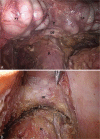Effect of preservation of Denonvilliers' fascia during laparoscopic resection for mid-low rectal cancer on protection of male urinary and sexual functions
- PMID: 27311004
- PMCID: PMC4998490
- DOI: 10.1097/MD.0000000000003925
Effect of preservation of Denonvilliers' fascia during laparoscopic resection for mid-low rectal cancer on protection of male urinary and sexual functions
Erratum in
-
Erratum: Medicine, Volume 95, Issue 24: Erratum.Medicine (Baltimore). 2016 Aug 7;95(31):e5074. doi: 10.1097/01.md.0000490009.39850.74. eCollection 2016 Aug. Medicine (Baltimore). 2016. PMID: 31265618 Free PMC article.
Abstract
The aim of this study was to investigate the effect of preservation of Denonvilliers' fascia (DF) during laparoscopic resection for mid-low rectal cancer on protection of male urogenital function. Whether preservation of DF during TME is effective for protection of urogenital function is largely elusive.Seventy-four cases of male mid-low rectal cancer were included. Radical laparoscopic proctectomy was performed, containing 38 cases of preservation of DF (P-group) and 36 cases of resection of DF (R-group) intraoperatively. Intraoperative electrical nerve stimulation (INS) on pelvic autonomic nerve was performed and intravesical pressure was measured manometrically. Urinary function was evaluated by residual urine volume (RUV), International Prostatic Symptom Score (IPSS), and quality of life (QoL). Sexual function was evaluated using the International Index of Erectile Function (IIEF) scale and ejaculation function classification.Compared with performing INS on the surfaces of prostate and seminal vesicles in the R-group, INS on DF in the P-group exhibited higher increasing intravesical pressure (7.3 ± 1.5 vs 5.9 ± 2.4 cmH2O, P = 0.008). In addtion, the P-group exhibited lower RUV (34.3 ± 27.2 vs 57.1 ± 50.7 mL, P = 0.020), lower IPSS and QoL scores (7 days: 6.1 ± 2.4 vs 9.5 ± 5.9, P = 0.002 and 2.2 ± 1.1 vs 2.9 ± 1.1, P = 0.005; 1 month: 5.1 ± 2.4 vs 6.6 ± 2.2, P = 0.006 and 1.6 ± 0.7 vs 2.1 ± 0.6, P = 0.003, respectively), higher IIEF score (3 months: 10.7 ± 2.1 vs 8.9 ± 2.0, P = 0.000; 6 months: 14.8 ± 2.2 vs 12.9 ± 2.2, P = 0.001) and lower incidence of ejaculation dysfunction (3 months: 28.9% vs 52.8%, P = 0.037; 6 months: 18.4% vs 44.4%, P = 0.016) postoperatively.Preservation of DF during laparoscopic resection for selective male mid-low rectal cancer is effective for protection of urogenital function.
Conflict of interest statement
The authors report no conflicts of interest.
Figures





References
-
- Park SY, Choi GS, Park JS, et al. Urinary and erectile function in men after total mesorectal excision by laparoscopic or robot-assisted methods for the treatment of rectal cancer: a case-matched comparison. World J Surg 2014;387:1834–42. - PubMed
-
- Kauff DW, Kempski O, Huppert S, et al. Total mesorectal excision-does the choice of dissection technique have an impact on pelvic autonomic nerve preservation? J Gastrointest Surg 2012;16:1218–24. - PubMed
-
- Shirouzu K, Ogata Y, Araki Y. Oncologic and functional results of total mesorectal excision and autonomic nerve-preserving operation for advanced lower rectal cancer. Dis Colon Rectum 2004;479:1442–7. - PubMed
-
- Heald RJ, Moran BJ, Brown G, et al. Optimal total mesorectal excision for rectal cancer is by dissection in front of Denonvilliers’ fascia. Br J Surg 2004;911:121–3. - PubMed
MeSH terms
LinkOut - more resources
Full Text Sources
Other Literature Sources
Medical
Miscellaneous

